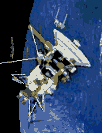|
Take a look at these two pictures and make the exercise of finding similarities
and differences.
To any scientist differences are obvious, huge, overwhelming. The urban
graffiti on the left is a useless cryptic message, almost a signature,
whereas the equation on the right is a meaningful mathematical expression
of one key law of Nature. Comparison is almost insulting, some could say.
I apologize if this hurts some sensibilities but we still need to ask ourselves
for similarities. The truth is that to the common layperson both statements
are equally cryptic. Both seem messages addressed to a narrow audience
of “colleagues”. We must admit that our scientific communications are most
of the time for our peers’ eyes only.
Science has never been open to the public. It is not now, it wasn’t either
back in the fifties, nor in Newton’s times, nor in the classical Greece.
But among other things, the 20th century has witnessed a incessant growth
of science, a remarkable growth that has led to recurring branching and
hyperspecialization and also to a greater impact of science and technology
on our society. This makes a difference. Our lives as individual members
of a technological society have never been so hastily tied to the developments
of the very technology that feeds our collective growth. In our industrialized
societies it is hard to find any aspect of our lives that has not been
touched by technologies rooted into the science developed in the last 100
years. And that touch ranges from minute aspects of our private lives to
global phenomena.
Well-informed citizens are the best basis for a democratic society. In
these days, as in the future, citizens will have to be aware of the
power of science, the blessings and also the responsibilities that come
with a technologically advanced society. For that, people need to
know how science works, what it means, what scientist can and cannot do.
This tells us of the need for divulgating science as broadly as possible,
an activity that has been quite borderline to scientist themselves in the
past but that will certainly increase in the near future.
Science will keep growing into the next century. And it will do so with
the great wonderful tools that has used in the past. A few trendy millennial
distractions will not put the scientific method out of business. And mathematics
will still be much more than our most elegant tool in the scientific endeavor.
Specialization will keep growing and scientists will necessarily keep writing
papers only fit to peer review. But in addition, as scientists, we have
a responsibility to let people – and other scientists in different fields-
know what we are doing. We need to let people discover what science is
about. |







